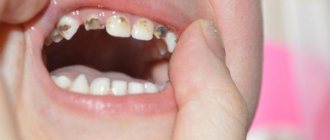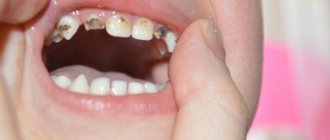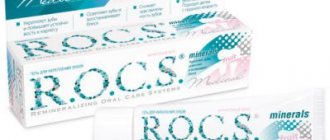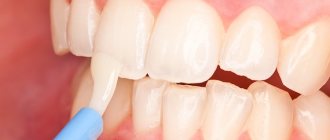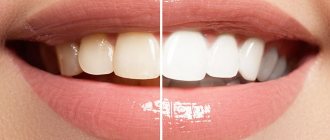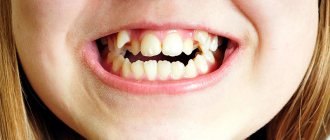From this article you will learn:
- how to silver teeth - photo,
- indications and contraindications for the procedure,
- preparations for silvering teeth in children.
The article was written by a practicing dentist.
Silvering of teeth is a conservative method of treating caries of primary teeth in children, which consists of impregnating the caries-affected areas of the tooth with silver. This method is most often used in children aged 2-3 years, or in children over 3 years old - with a strong fear of the dentist. The method has its drawbacks, and is not indicated for every child, but in some cases it is the only way to do without removing teeth before their physiological change.
In dentistry, the following drugs are usually used to silver baby teeth in children: Saforide or two-component Argenate. The effectiveness of silver plating will largely depend on the stage of the carious process. The method will be especially effective in the initial form of caries in the white spot stage, as well as superficial caries (i.e. in cases where the carious process does not extend beyond the enamel layer). With average caries, when dentin is already damaged, the method has very limited effectiveness.
Teeth after silvering: photo
Silvering of teeth in children can be performed from the moment they erupt (from 6 months), the procedure does not require anesthesia and is well tolerated even by emotionally unbalanced children. The visible disadvantage of the method is the change in the color of the teeth - which must be warned in advance to the child’s parents, having obtained their consent to use the method. In this case, only demineralized areas of tooth enamel affected by caries change their color (the color of healthy enamel does not change).
What is silvering of teeth
Silvering is an old technique that is still used in some dentistry in an attempt to protect baby teeth affected by caries. To do this, the doctor simply covers the infected area of enamel with silver.
Today, the very idea of clogging dangerous microorganisms in tooth tissue under a layer of metal seems strange, but some doctors are still convinced that such a method of combating caries has a place. Why? Because silver has antimicrobial properties.
Indeed, such a film can prevent the development of caries, but only if it is at a very early stage, when the enamel has become loose and bacteria have just begun to colonize its cells. Finding caries in a child at this stage is an almost impossible task, and in other cases, silvering will not only not bring the promised result, but can even cause harm to the teeth.
Silvering of teeth can only be effective when caries is in the white spot stage. Then an antimicrobial film created from metal can really protect tooth tissue from further penetration of microorganisms and destruction of enamel tissue.
Important information about the silver plating procedure
- If caries has managed to overcome the initial stage and is already affecting the dentin, then silvering in this case will be a useless measure. Dentin in children is softer than in adults, and caries develops at twice the rate. When caries has entered the middle stage, even with silvering once a month there is no absolute guarantee that the lesion will not develop into pulpitis. Remember that silver plating is not a panacea! The procedure makes it possible to hold out until the child reaches the age of 3 years in order to carry out full treatment.
- Applying silver to exposed dentin can cause burns to the pulp, which will lead to the development of pulpitis, as the chemicals will be able to easily penetrate the nerve of the tooth. The onset of pulpitis is indicated by severe pain that is difficult to relieve. The doctor performing silvering must accurately calculate the time of application of the solution so as not to damage the pulp.
- Teeth treated with silver change their color, especially if their surface is treated with Russian or Belarusian preparations. The teeth take on a black tint, which looks extremely unaesthetic. Japanese-made solutions also change the color of teeth, but not to black, but to light gray, which is not so noticeable.
Why is it important to save every baby tooth?
- To protect permanent teeth.
Advanced caries can not only lead to the destruction of milk teeth, but also damage the rudiments of permanent ones. - To form the correct bite.
Early removal of baby teeth will lead to displacement of the dentition, and the permanent bite will be incorrect. - For the health of body systems.
Long-term absence of teeth can lead to disruption of the digestive system, as the child will not be able to chew food well.
SILVER PLATING AT HOME
Many parents are interested in whether it is possible to silver teeth themselves? Dentists prohibit doing this, since without medical education it is impossible to carry out silvering correctly using dental preparations.
Silver plating can cause harm instead of benefit if it is applied to a tooth with deep carious lesions. It is impossible to independently determine the degree of tissue damage. Therefore, experimenting with treatment is strictly prohibited.
Another point is to clean the enamel from plaque. Parents will not be able to properly clean the surface of their teeth from plaque, so coating with a silver film “solders” the plaque to the enamel. After this, it will be difficult to clean the enamel from such a layer.
How does silvering of teeth occur?
Silver plating is done only on baby teeth. This is an absolutely painless procedure, it takes from 10 minutes to half an hour - it all depends on how many teeth need to be covered.
First, the dentist examines the baby’s oral cavity, then removes plaque from the surface of the infected tooth and applies a composition to the enamel. In fact, for silvering it is not pure silver that is used, but a special solution - silver nitrate. It enters into a chemical reaction and blocks the dentinal tubules, preventing bacteria from accessing them.
Over time, the film deteriorates, so it is recommended to repeat the procedure regularly - at least once every 6 months.
After teeth silvering, their color becomes dark and the smile becomes unaesthetic. That is why this method of combating early-stage caries is not used when it comes to permanent teeth.
Indications
You cannot silver permanent teeth - only baby teeth. The method is justified in the following forms of caries found on the front teeth:
- surface;
- medium (assuming the cavity is shallow and the patient will carefully care for the treated units);
- planar (I mean a defect in which the entire crown or several adjacent teeth are affected);
- circular (dental neck is affected).
It is also recommended to carry out the procedure if the child’s enamel is insufficiently mineralized.
It is not advisable to use silver when working with molars. If they already have holes, only filling will help. This is due to the fact that food particles will constantly accumulate in the chewing teeth, which means that the destructive process will continue.
To silver teeth or not?
Silvering is a painless procedure, but its effect may not only not meet your expectations, but also negatively affect the child’s attitude towards dental treatment.
Firstly, before the procedure, the doctor needs to thoroughly clean the baby’s teeth, and this can frighten him. Secondly, the black color of the enamel will cause psychological discomfort to the baby - he will begin to feel embarrassed about his smile.
In addition, silvering of a tooth with moderate or deep caries can be dangerous. Bacteria remain sealed in the dentinal tubules and actively multiply there, while the enamel darkened due to silver nitrate does not even give parents a chance to notice this process. As a result, caries develops into pulpitis within a few months, and a tooth that could be saved has to be removed.
In addition, during the procedure, the composition may get on the gums. Itching, redness or burns occur in this area, and even an allergic reaction is possible.
Silvering of teeth does not cure, it can only stop the development of caries, but only when it comes to damage to the upper layer of enamel.
Disadvantages of the technique
The main disadvantage of using silver in dentistry is that after the procedure an unsatisfactory aesthetic result is obtained. The dentition takes on an unsightly black color. It is clear that because of this, the appearance of the smile deteriorates.
While the child is three or four years old, he does not pay attention to his unusual smile, but as he grows up, this may cause problems. The likelihood of their occurrence is especially high when the baby goes to kindergarten or school, where peers may start making fun of him. There is no way to remove the dark shade - you need to wait until the baby tooth is replaced by a permanent one.
Another disadvantage of silvering is that you need to carry out several consecutive sessions. In most cases, a child will have to visit the dentist about five times. It is clear that each such visit is associated with certain troubles for parents.
Silver will not help with deep caries. If the resulting cavity is large, you will have to put a filling. Therefore, it is very important to “keep your finger on the pulse” and monitor changes in the condition of the child’s dentition.
Which is better: fluoridation or silvering of teeth?
Fluoridation is an alternative to silvering teeth. This is a gentle procedure that strengthens the enamel, making it denser and more reliable. Thanks to this, acids - the main cause of caries - will not be able to damage the strengthened surface of the tooth.
At the same time, fluoridation, like silvering, does not treat teeth and does not relieve them of caries, but it helps prevent infection from penetrating the enamel tissue. In addition, this procedure has a positive effect on its shade - it makes it lighter.
CARRYING OUT THE PROCEDURE
First, the dentist cleans the surface of the tooth so that no foreign particles from food remain on it. Then apply the mixture with a cotton swab and leave until hardened. They don't do anything else.
What is the coating solution made of? It contains silver nitrate - 30%. In dental practice, fluoride compounds can be added to silver nitrate, which have a strengthening effect on the enamel.
Note! The method of silvering baby teeth will need to be repeated several times. The dentist will notify you about this.
How many times does silvering need to be done? Sometimes this is done every three months, sometimes the baby needs to repeat the procedure every six months. What determines the frequency of the procedure? This is due to the type of feeding (breastfeeding or formula feeding) and the structure of the enamel of the molars. Thin enamel requires more careful care than durable enamel.
When is re-silvering required? The film wears off over time due to chewing of food. The silver film reacts to acids from food, so the child must be shown to the dentist regularly.
ARGENATE AND SAPHORITE
Modern dentistry suggests using drugs such as Argenate and Saforite containing silver fluoride diamine.
Argenate can be one-component or two-component. One-component is used to strengthen enamel and clog dentin tubules. The two-component drug has a similar effect for a longer period. It is used in the treatment of cervical caries, since the petroleum jelly contained in the composition protects the mucous membrane from burns by silver ions. After using Argenate, a dark film forms on the teeth, just like after silvering.
The drug Saforide is an analogue of Argenate of Japanese origin, therefore it costs many times more. In terms of the quality of the effect, it does not differ from Argenate. After imported drugs, teeth darken in the same way and are not cleaned with toothpastes.
What to do to avoid silver teeth
- Visit your pediatric dentist regularly for checkups and learn how to properly and thoroughly brush your teeth.
- Help brush your child's teeth until you are sure that the baby can now handle this task well on his own.
- Regularly undergo professional oral and dental hygiene. Depending on the age of the child, the set of procedures differs, but its main task is to remove all plaque and tartar.
- Carry out fluoridation and remotherapy to strengthen the enamel and protect it from bacteria and acids.
- Seal the fissures of the chewing teeth. This is a safe and painless procedure that will reliably protect against caries.
To silver teeth or not, each parent decides for himself. But when choosing this procedure, it is important to understand that it will not protect the baby’s baby teeth from caries and will not cure them, but on the contrary, it can cause early tooth extraction and the appearance of complexes in the child. Today there are alternative methods of silvering. They are safe, effective and really help prevent the occurrence of caries and its complications. Doctors at the Center for Modern Dentistry clinic daily and successfully use these methods to strengthen and protect your teeth.
Reasons for the development of early childhood caries -
As we said above, any means of treating caries will not be very effective if parents are not ready to implement or control the quality of oral hygiene in the child. It will also not be possible to achieve a positive result if you allow your child to eat between main meals - sweets, flour, starchy foods, drink sweet soda, or sweet or sour juices. Thus, without following a diet and controlling the consumption of easily digestible carbohydrates, the effect of treatment will tend to zero.
Our website has professional reviews on oral hygiene in children that will help you avoid the risk of developing caries in your child altogether. You can write your questions in the comments to this article. And we hope that our article: Silvering teeth for children reviews - was useful to you!
Sources:
1. The author’s higher professional education in dentistry, 2. Based on 20 years of personal experience as a dentist, 3. The European Academy of Paediatric Dentistry (EU), 4. National Library of Medicine (USA), 5. “Pediatric therapeutic dentistry. National leadership" (Leontyev V.K.).
Advantages of the method
In addition to the absence of pain, silvering teeth in children has many more advantages:
- Treatment is carried out with an inexpensive drug and in a short time, which reduces the cost of the procedure.
- The solution is safe for children's bodies and is suitable even for infants.
- Preserves the development of caries.
- There is no risk of injuring the baby and creating a fear of treatment at the dentist.
Painlessness during the procedure is one of the main advantages of the method. The drug is applied without the use of dental instruments, using a soft applicator. This is very convenient for children 2–3 years old; it is at this age that caries first makes itself known.
Alternative methods
Medicine is developing rapidly, so many clinics offer other methods of painless treatment and prevention of caries. If there are contraindications to the silvering procedure, the following options can be used:
- Remineralization . The affected part is treated with fluoride-containing preparations by spraying, after which the tooth tissue becomes strong due to the formation of a mineral film. Unlike silver plating, fluoridation preserves the color of the enamel.
- Ozonation . It is a method of treating teeth with ozone. In the process, a significant part of pathogenic microorganisms is destroyed. Requires repeated repetition for greater effectiveness.
- Sealing tooth fissures . The method combines preventive and therapeutic effects. The tooth cavities are filled with a sealant-type agent, which prevents the subsequent development of the carious process. The drug also contains microelements and minerals necessary for enamel.
- Treatment with a drill . To make the process painless, pediatric dentists use ointments and sprays that have a local anesthetic effect. If the doctor is experienced and can establish contact with the child, the treatment will take place without pain and stress, and subsequently the child will not be afraid to have his teeth treated.
The listed methods are mainly suitable for children from 3 years old; their cost is much higher than the price of the silvering procedure.
Important! The choice of treatment method is influenced by many factors: how much the service costs, what the tooth looks like after it, whether the child hurts or not during treatment, and whether a durable coating is formed with each method. But a specialist must decide whether to silver a child’s teeth or not.
Drugs and costs
The main preparations for silvering teeth in children include the domestic “Argenat” and “Saforaid”, produced in Japan. The first solution is available in one- and two-component forms. Contains silver fluoride diamine. When interacting with calcium ions, it forms calcium fluoride and silver orthophosphate, which have a bactericidal effect.
It is believed that the Japanese drug contains an ideal combination of fluorine and silver ions. Its disadvantage is its high price, an order of magnitude higher than that of Argenat.
The cost of the service depends on the degree of damage, location and level of the clinic, and the drug used. The lower price threshold starts from 30 rubles and ends in the range of 680–800; on average, the procedure costs 150 rubles per tooth. In dental clinics, services for children can be provided free of charge, if this is provided for by the Territorial Compulsory Medical Insurance Program.
Additional recommendations and rules
Silvering is a method that stops the development of caries for a short period of time. To protect your child from premature painful treatment or complete tooth extraction, you should follow the rule: the procedure is carried out at the frequency established by the doctor. Before starting the session, you should brush your teeth several times under the supervision of an adult. It is necessary to completely remove plaque from the enamel, even in the most inaccessible places.
If there are pathogenic microorganisms in the oral cavity, then during their vital activity an acid is produced that destroys the applied layer. Therefore, when a child has been ill with a bacterial infectious disease, then 2 weeks after complete recovery you should consult a dentist. In such cases, it is recommended to silver teeth more often.
Today, silvering of teeth is recommended for children with chronic tonsillitis, otitis, inflammation of the adenoids, stomatitis and gastrointestinal problems. A healthy oral cavity is the key to normal microflora of the whole body. And if the tooth enamel is intact and undamaged, then there is no necessary environment for the growth of harmful bacteria, which can cause chronic diseases.
Expert of the article you are reading:
Lozinskaya Alla Nikolaevna
Pediatric dentist, general dentist.
You may also be interested in:
Children's orthodontist Dental treatment for children Correction of bite in children Features of the treatment of childhood caries Treatment of pulpitis of baby teeth Removal of baby teeth Prevention of childhood caries
Show more
